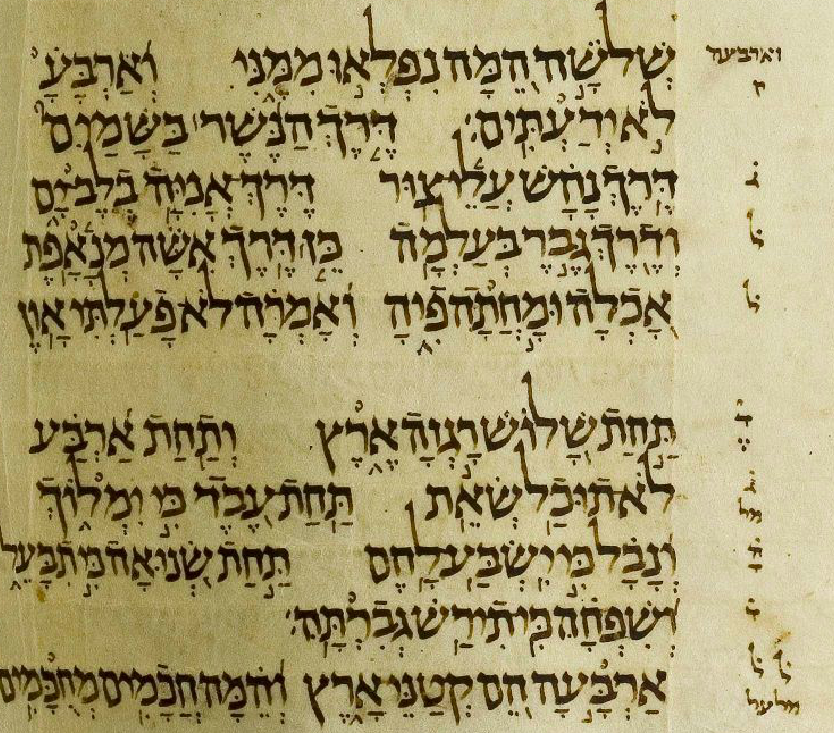Ezra/Neḥemiah (considered one book in the traditional Tanakh count), Chronicles, and Daniel are surprisingly important to Jewish tradition given their absence in the liturgical calendar of readings. The great tannaitic sage Rabbi Yosei said, “Ezra would have been worthy for the Torah to be given by him to the Jewish people, had Moses not already done so” (Sanhedrin 21b). Daniel is considered to be the earliest source for the custom to pray three times a day (Dan. 6:11), and his supplications (Dan. 9:5) form the basis of the traditional confession liturgy. And we traditionally read substantial portions from Chronicles (1 Chron. 16:8-36 and 1 Chron. 29:10-13) and Neḥemiah (Neh. 9:6-11) every morning during P’sukei. Why shouldn’t such fascinating and unique books have a melody of their own?
The following system is meant to rectify this absence. Inspired by the basic melodic structures of Ashkenazi cantillation, this system uses its own modalities and flourishes to reflect the unique and fascinating nature of these books – angst-ridden yet hopeful, regretful yet optimistic, and relevant. Perhaps one could use this system for the morning readings, perhaps in personal study, or perhaps one could organize a group to read these texts together. Perhaps these three books have no tradition, but may this system become its own tradition as the years go by.
Cantillation System:
Example:
Musical Notation
Click to access Ezra_Nehemiah_Chronicles_Daniel-Cantillation-System-Isaac-Gantwerk-Mayer-2018.pdf

“An Ashkenazi-style Cantillation System For Ezra/Neḥemiah, Chronicles, and Daniel, by Isaac Gantwerk Mayer” is shared through the Open Siddur Project with a Creative Commons Attribution 4.0 International license.










The proposal to leyen, give a public airing, to these otherwise neglected books, only ever read in private study, is excellent.
But why the rather awkward contrived trop, with added semitones and stretched intervals? If we want to capture a distinctive flavour of the texts, we could see whether they are or have ever been been chanted by oriental Jews, or Samaritans, or Karaites. Or apply the Job-mode that some oriental Jews use? But is any such search necessary? Why not the haftarah trop, familiar to the likely hearers and capable of heightened expression when necessary? The mostly narrative passages in these books are typical haftarah material.in text and t’amim. There are special reasons, occasions, for special trops for the three megillas, Eicha and Esther. What occasions call for these later books?
Regarding your first question, admittedly the range is somewhat large, but I tried not to make the system too complicated. Many of the mordents/krekhtn could be treated as optional if preferred. My basic ideas were based on Binder’s systems, and he has a habit of including all sorts of semitones etc. Simplification would be fine if you’d prefer a less cantorial variety.
Why not Haftarah trope? i tried to explain this above, but I guess I wasn’t clear enough. I feel like the perspective of Chronicles, Ezra/Nehemiah and Daniel is distinctly different from the perspective of the Neviim. Whereas Kings ends in exile, Chronicles ends in return from exile. Ezra/Nehemiah conclude with a successful reestablishment of a Jewish state in Judaea. And Daniel predicts the end of days as a period of universal justice and redemption. So I attempted to define a more major, optimistic system.
Regarding question 3, here are a few ideas.
-As mentioned above, we read from Chronicles and Nehemiah every day. Perhaps on special occasions we could recite it out loud in a cantillation fashion.
-The book of Daniel is considered to make reference to the period of King Antiochus IV, the villain of the Ḥanukah story, as the קֶֽרֶן־אַחַ֖ת מִצְּעִירָ֑ה – the little bitty horn. Perhaps we could read Daniel chapter 8 during Ḥanukah.
-The text of Daniel 9:1-20 is the archetype for the penitential/supplicatory prayers Jews have been saying ever since, so it might be an appropriate reading for fast days or for the 10 Days of Repentance.
-The Ethiopian Betä Ǝsraʔel community recites Nehemiah 8 and Nehemiah 9 when commemorating/celebrating Sigd, a commemoration of the preservation of the covenant in exile celebrated on the 29th of Ḥeshvan. Sigd is a fascinating holiday and one I personally believe should be universally explored, covering concepts relevant to all of Jewry no matter its origin. A recitation of Nehemiah 8-9 according to this trop system would be a respectful way to commemorate this unique sacred occasion.
While I am not totally enamored of all the melodic licks, some of them feel fine to me; I would lean towards more obvious modal scales for this kind of work (unless you want to use a tone row….). I concur that alternative trop melodies for different books is a form of enrichment. Just using haftara trop is an option, but why choose cultural poverty? There are Mizrachi traditions that use a different maqam for every torah parasha. Also, consider setting these texts to trop in English. You’d be amazed at the positive response you get when people actually understand what you are saying.
I want this system but am not Jewish and cannot understand how to get the passages related to the Torah readings. Date Torah Haftarah Tanakh Ps. Would you help me?
Hi Cheryl. Understanding the cantillation marks in the Masoretic tradition held by Rabbinic and Karaite Jews is not crucial to understanding the Tanakh (Hebrew Bible). Besides offering a structure for chanting the text, the cantillation marks are helpful in parsing the verses and in expressing emphasis of particular words and phrases.